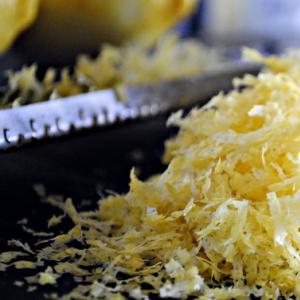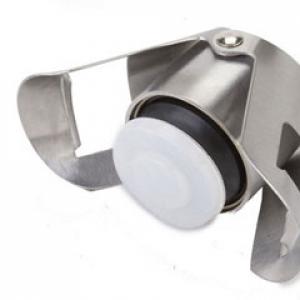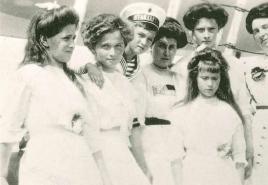Test work on the topic molecular level. Biology test on the topic "Molecular level" (grade 9)
Test. Molecular level. Option 1. 9th grade.
A1.Which chemical element is contained in cells in the greatest quantity:
1.nitrogen
2.oxygen
3.carbon
4.hydrogen
A2.Name chemical element, which is part of ATP, all monomers of proteins and nucleic acids.
1)N 2)P 3)S 4)Fe
A3.Indicate a chemical compound that is NOT a carbohydrate.
1) lactose 2) chitin 3) keratin 4) starch
A4.What is the name of the protein structure, which is a helix of a chain of amino acids, coiled in space into a ball?
A5. In animal cells, storage carbohydrate is:
1.starch
2.cellulose
3.glucose
4.glycogen
A6. The main source of energy for newborn mammals is:
1.glucose
2.starch
3.glycogen
4.lactose
A7.What is an RNA monomer?
1) nitrogen base 2) nucleotide 3) ribose 4) uracil
A8. How many types of nitrogenous bases are included in the RNA molecule?
1)5 2)2 3)3 4)4
A9.Which DNA nitrogenous base is complementary to cytosine?
1) adenine 2) guanine 3) uracil 4) thymine
A10. Molecules are the universal biological energy accumulator
1).proteins 2).lipids 3).DNA 4).ATP
A11. In a DNA molecule, the number of nucleotides with guanine is 5% of the total number. How many nucleotides containing thymine are in this molecule?
1).40% 2).45% 3).90% 4).95%
A12.What is the role of ATP molecules in the cell?
1-provide a transport function 2-transmit hereditary information
3-provide vital processes with energy 4-accelerate biochemical
reactions
IN 1. What functions do carbohydrates perform in a cell?
Catalytic 4) structural
Energy 5) storage
Motor 6) contractile
AT 2. Which structural components are part of the nucleotides of the DNA molecule?
Various acids
Lipoproteins
Deoxyribose carbohydrate
Nitric acid
Phosphoric acid
AT 3. Establish a correspondence between the structure and function of organic matter and its type:
STRUCTURE AND FUNCTION OF SUBSTANCE
A. consist of residues of glycerol molecules and fatty acids 1. lipids
B. consist of residues of amino acid molecules 2. Proteins
B. Participate in thermoregulation
D. Protect the body from foreign substances
D. are formed due to peptide bonds.
E. They are the most energy-intensive.
C1. Solve the problem.
There are 1250 nucleotides in a DNA molecule with adenine (A), which is 20% of their total number. Determine how many nucleotides with thymine (T), cytosine (C) and guanine (G) are contained individually in a DNA molecule. Explain your answer.
Total: 21 points
Evaluation criteria:
19 -21 points – “5”
13 – 18 points – “4”
9 – 12 points – “3”
1 – 8 points – “2”
Test. Molecular level. Option 2. 9th grade
A1. Four chemical elements account for 98% of the total contents of the cell. Indicate a chemical element that is NOT one of them.
1)O 2)P 3)C 4)N
A2. Children develop rickets with a deficiency of:
1.manganese and iron
2.calcium and phosphorus
3.copper and zinc
4.sulfur and nitrogen
A3.Name the disaccharide.
1) lactose 2) fructose 3) starch 4) glycogen
A4. What is the name of the protein structure, which is a spiral that is folded into a chain of amino acids?
1) primary 2) secondary 3) tertiary 4) quaternary
A5. In plant cells, reserve carbohydrate is:
1.starch
2.cellulose
3.glucose
4.glycogen
A6. The greatest amount of energy is released during the decomposition of 1 gram:
1.fat
2.squirrel
3.glucose
4.carbohydrates
A7.What is a DNA monomer?
1) nitrogen base 2) nucleotide 3) deoxyribose 4) uracil
A8. How many polynucleotide strands are included in one DNA molecule?
1)1 2)2 3)3 4)4
A9.Name a chemical compound that is found in RNA but not in DNA.
1) thymine 2) deoxymyribose 3) ribose 4) guanine
A10. Molecules are the source of cell energy
1).proteins 2).lipids 3).DNA 4).ATP
A11. In a DNA molecule, the number of nucleotides with cytosine is 5% of the total number. How many nucleotides containing thymine are in this molecule?
1).40% 2).45% 3).90% 4).95%
A12.What compounds are included in ATP?
1-nitrogen base adenine, carbohydrate ribose, 3 molecules of phosphoric acid
2-nitrogen base guanine, sugar fructose, phosphoric acid residue.
3-ribose, glycerol and any amino acid
Part B (choose three correct answers from the six proposed)
IN 1. Lipids perform the following functions:
Enzymatic 4) transport
Energy 5) storage
Hormonal 6) transmission of hereditary information
AT 2. What structural components make up the nucleotides of an RNA molecule?
Nitrogen bases: A, U, G, C.
Various acids
Nitrogen bases: A, T, G, C.
Ribose carbohydrate
Nitric acid
Phosphoric acid
AT 3. Establish a correspondence between the features and the molecules for which they are characteristic.
FEATURES OF THE MOLECULE
A) are highly soluble in water 1) monosaccharides
B) have a sweet taste 2) polysaccharides
C) no sweet taste
D) glucose, ribose, fructose
D) insoluble in water
E) starch, glycogen, chitin.
C1. There are 1100 nucleotides in a DNA molecule with cytosine (C), which is 20% of their total number. Determine how many nucleotides with thymine (T), guanine (G), adenine (A) are contained individually in a DNA molecule, explain the result obtained.
Part A – 1 point (maximum 12 points)
Part B – 2 points (maximum 6 points)
Part C – 3 points (maximum 3 points)
Total: 21 points
Evaluation criteria:
19 - 21 points – “5”
13 – 18 points – “4”
9 – 12 points – “3”
1 – 8 points – “2”
"Molecular level"
9th grade
1 option
1. DNA monomer2. Where is the hereditary material of viruses located?A) in the cytoplasm; B) in the nucleus;B) in a special shell.
3. DNA does not contain nucleotides:
a) ribose b) thymine c) uracil
4. Primary structure squirrel
5. Functions of mRNAA) stores genetic information; B) collects protein molecules;C) transfers genetic information from the nucleus to the site of protein synthesis;D) delivers amino acids to the ribosome.
6. Protein monomerA) amino acid; B) nucleotide;B) monosaccharides; D) glycerol and fatty acids.
7. The correspondence A-T, G-C, A-U is called:
a) transcription b) reduplicationee c) complementarity. The DNA strands are held together by:
a) peptide bonds b) ionic bonds c) hydrogen bonds
9. Protein secondary structureA) chain of amino acids; B) globule;B) spiral; D) several globules collected into a single complex.
10. Functions of DNAA) stores genetic information; B) delivers amino acids to the ribosome;D) collects protein molecules; D) participates in protein biosynthesis.
11. RNAs are found in:
a) nucleus b) cytoplasm c) ribosomes
12. The process of loss of natural protein structure:
a) renaturation b) denaturation
c) homeostasis
13. Biological catalysts are:
a) antigens b) antibodies c) enzymes
14. Enzyme:
a) accelerates several types of reactions at once
b) operates within narrow temperature limits
c) can only work at a certain pH value of the environment
15. Functions of carbohydrates in animal cells:
a) storage b) energy
c) transport
16. Fiber and chitin are examples of:
a) polysaccharides b) monosaccharides c) disaccharides
17 .What is the name of an organic substance whose molecules contain C, O, H atoms, performing an energy and construction function?A-nucleic acid B-proteinB-carbohydrate G-ATP
18.What carbohydrates are polymers?A-monosaccharides B-disaccharides C-polysaccharides19.The group of monosaccharides includes:A-glucose B-sucrose C-cellulose 20.What is the role of ATP molecules in the cell?A-provide the transport function B-transmit hereditary information C-provide vital processes with energy D-accelerate biochemical reactions
21. Define the terms: DNA, RNA, complementarity, nucleotide, cellulose.22. Problem: A section of a DNA molecule has the following structure:AATGCGATGCTTAGTTTAGG, it is necessary to complete the complementary chain of i-RNA.
Test in biology
"Molecular level"
9th grade
Option 2
1. Lipids differ from other substances:a) hydrophilic parts
b) hydrophobic parts
c) solubility in water
2. Protein monomers are:
a) amino acids b) monosaccharides c) nucleotides
3. Proteins are:
a) polynucleotides b) polypeptides
c) polysaccharides
4. Arrange the protein structures in sequence:
a) globule b) polymer chain
c) spiral
5. Hydrogen bonds occur in:
a) proteins b) nucleic acids
c) lipids
6. The following is not found in RNA:
a) ribose b) adenine c) glycerol
7. RNA most often consists of:
a) one chain b) two chains
c) individual nucleotides
8. Glycogen performs:
a) transport b) catalytic
c) storage function
c) tertiary and secondary; d) tertiary, secondary and primary.
10. Of the indicated compounds, the following has a lipid nature:a) hemoglobin; b) insulin; c) testosterone; d) penicillin.
11. The DNA strands are held together by:
a) peptide bonds b) ionic bonds
c) hydrogen bonds
12. Monomer of fiber, starch, glycogen is1) fructose 2) amino acid 3) glucose 4) ribose13.How many of the known amino acids are involved in protein synthesis?A-20 B-100 B-23
14. What part of the amino acid molecules distinguishes them from each other?A-radical B-carboxyl group B-amino group
15. What compounds make up ATP?A- adenine, ribose carbohydrate, 3 molecules of phosphoric acidB- guanine, fructose sugar, phosphoric acid residue.B-ribose, glycerol and any amino acid
16. The nucleotide complementary to guanyl nucleotide is:A-thymidyl B-cytidylB-adenylic G-uridylic
17.Which scientist proposed the term “biology”:A) C. Darwin;B) A. Levenguk; B) T. Ruz; D) L. K. Treviranus.
18. Glycogen and cellulose are examples of:
a) polysaccharides b) monosaccharides
c) disaccharides
19.monomers of nucleic acids are:A-amino acids B-fatsB-nucleotides G-glucose
20.What class of chemical substances does ribose belong to?A-protein B-carbohydrate C-lipid
21. Task.In what sequence will the nucleotides be located in the mRNA if the DNA chain has the following composition: GGTATAGCGCTTTAAGCCTT.
22. Define the terms: polysaccharides, enzymes,renaturation, monomer, chitin.
Choose one correct answer:
Of the listed elements, the largest quantities present in living cells are:
a) magnesium; b) nitrogen; c) phosphorus;G)carbon.
Tertiary structure of transport proteins and enzymes in the process of performing their functions:
a) does not change; b) changes;V)neenters the secondary structure;d) goes into a quaternary structure.
During protein denaturationnot happening
their destruction:
A)primary structure;b) secondarystructures; c) tertiary structure;
d) quaternary structure.
Polymers include:
A) cellulose, sucrose, starch;b) inulin, glycogen, ribose;V)starch, inulin, cellulose;d) keratin, lecithin, fructose.
Function of mRNA:
a) is part of ribosomes; b) transports amino acids; c) storage of hereditary information; G)code transmissionhereditary information about the primary structure of the protein.
ATP is an important molecule in metabolism because:
A)it contains high-energy phosphate bonds;+
b) its phosphate bonds are very easily formed, but not easily broken;
c) it can be quickly obtained from the environment surrounding the body;
d) it is extremely stable.
Protein that is part of feathers, hair, horns, nails:
a) actin;b)keratin;+
c) tubulin;d) myosin.
From the following mineral elementsis not necessary for plants:a) potassium; b) magnesium; c) calcium;G)lead.
Substitute nutrient mushrooms Iis:
a) starch;b)glycogen; c) inulin;d) cellulose.
Substance that is poorly soluble in water:
A)heparin;b) glucose;c) vitamin C;d) mineral salts.
11. Which substance is hydrophilic:
a) lipid; b) cellulose;V)sucrose; d) chitin.
12 . Organic substances that ensure the storage of hereditary information are:
a) proteins; b) fats; c) carbohydrates;G)nucleic acids.
13 . Hydrolysis of starch to glucose occurs:
a) pepsin;b)amylase; c) lipase; d) trypsin.
14 . What substance is shown in the picture?
a) DNA, b) RNA,V)ATP, d) protein
15. Proteins that can accelerate chemical reactions perform the following functions in the cell:
a) hormonal; b) signal;V)enzymatic; d) informational.
16. For a DNA sectionACCGATTGGG indicate the complementary chain:
a) AAGGTCAGT;b)TGGCTAACC; c) TCTGTTACG; d) TGGCATTATS.
17. Hydrolysis of fats to fatty acids and glycerol carries out:
a) pepsin; b) amylase;V)lipase; d) trypsin.
18. Indicate a pair of complementary nucleotides in a DNA molecule:
a) A=G;b)A=T; c) A=U; d) A=C.
a) mushrooms;b)viruses; c) bacteria; d) plants.
20. Select disaccharide:
A)sucrose; b) ribose; c) glucose; d) starch.
Select several O option ov answer :
The source of energy for metabolism can be:
A)proteins;+
b)fats; +
c) fat-soluble vitamins;G)carbohydrates; +
e) mineral salts; e) water.
Phosphoric acid is part of the substances:
A)DNA; b) proteins;V)RNA; d) amino acids; e) carbohydrates;e)ATP.
Polysaccharides are:
A)glycogen; b) sucrose;V)cellulose;G)murein; e) maltose; e) fructose.
Lipids play a role in living organisms:
a) enzymatic;b)reserve;V)structural;G)protective; e) receptor; e) motor.
The nucleotide contains:
A)phosphoric acid residue; b) amino acids; c) lipids; d) enzymes;
d)carbohydrate ribose or deoxyribose;e)nitrogenous base.
Select with one answer option from four possible, but requiring pre-multiple selection:
Compared to the extracellular environment, the concentration of ions in the cytoplasm of a neuron is increased -I) sodium,II) potassium,III) calcium,IV) chlorine,V) magnesium.
A)I,
II;
b)I,
IV;
V)II,
V;
G)II,
III.
DNA in eukaryotic cells is found in -I) cytoplasm,II) core,III) mitochondria,
IV) lysosomes,V) ribosomes:
A)I,
II,
III,
V; b)I,
II,
IV;
V)II,
III; G)II,
V.
As a transport form of carbohydrates, living organisms use:
I) starch,II) glucose,III) glycogen,IV) sucrose,V) maltose.
A)II,
V;
b)I,
IV;
V)II,
IV;
G)II,
V.
4. In living organisms, the transport function is performed by proteins:
I) hemoglobin,II) hemocyanin,III) catalase,IV) globulins,V) elastin.
A)I, II, III, V; b)I, II, IV; V)II, III; G)II, V.
Match the names of proteins (A–D) with their functions in the human body (1–5).
Protein
A. Trypsin
B. Myosin
B. Hemoglobin
G. Keratin
D. Antibodies
Function
1. Structural
2. Catalytic
3. Protective
4. Motor
5. Transport
Function
1
2
3
4
5
Protein
GG
AA
DD
BB
ININ
Establish a correspondence between the features of carbohydrate molecules and their types:
Features of molecules
Types of carbohydrates
1. Monomer
A- cellulose
2. Polymer
3. Dissolves in water
B- glucose
4. Insoluble in water
5. Included in cell walls plants
6. Contains cell sap
Features of molecules
1
2
3
4
5
6
Types of carbohydrates
BG
AA
BD
AB
AIN
A judgment is given, each of which must be either agreed or rejected.
Organogenic chemicals are:O, C, H, N. +
DNA contains a nitrogenous base, the sugar ribose, and a phosphoric acid residue. -
The monomers of DNA and RNA are nucleotides.+
Amino acid protein monomers.+
Lipids are hydrophilic substances in relation to water.-
When 1 g of fat is broken down, 17.6 kJ of energy is released.-
Magnesium is part of chlorophyll.+
Most enzymes are proteins.+
RNA is a double unbranched linear polymer.-
Sucrose is a disaccharide and is found only in plants, where it is the main transported substance.+
Molecular level 1 option
1.What is the name of an organic substance whose molecules contain C, O, H atoms, which performs energy and construction functions?
A-nucleic acid B-protein B-carbohydrate G-ATP
2.What carbohydrates are polymers?
A-monosaccharides B-disaccharides C-polysaccharides
3.The group of monosaccharides includes:
A-glucose B-sucrose C-cellulose
4. Nucleic acid monomers are:
A-amino acids B-fats C-nucleotides G-glucose
5. a substance necessary for all chemical reactions in the cell, playing the role of a solvent for most substances, is...
A-polenucleotide B-polypeptide C-water D-polysaccharide
6.Fats perform the following functions in the cell:
A - transport B - energy
B - catalytic G - informational
7.What compounds do lipids belong to in relation to water?
A- hydrophilic B- hydrophobic
8.What is the importance of fats in animals?
A-membrane structure B-thermoregulation
B- source of energy D- source of water D- all of the above
9. Protein monomers are:
A-nucleotides B-amino acids C-glucose G-fats
10. What is the name of the reversible process of disruption of the structure of one of the most important organic compounds of the cell, occurring under the influence of physical and chemical factors?
A-polymerization of glucose B-denaturation of protein
B- DNA doubling D- fat oxidation
11. The amount of adenine in DNA is always equal to the amount...
A - thymine B - guanine C - cytosine D-uracil
12. In what sequence will the nucleotides be located?second strand DNA and in mRNA , if the DNA chain has the following composition: TAC - GGT-ATA-GCH-CTT-AAG-CCT-CAT-ATC
chain of amino acids primary structure of the encoded protein. Write it down anticodons
tRNA, encoding these amino acids.
Molecular level 2 option
Choose one correct answer
1. How many of the known amino acids are involved in protein synthesis?
A-20 B-100 B-23 G-150
2. The greatest energy value(based on the amount of energy released from 1 g) has:
A) fat; B) starch; B) protein; D) cellulose
3.What compounds make up DNA?
A- nitrogenous base, deoxyribose, phosphoric acid residue
B- guanine, ribose, phosphoric acid residue.
B-ribose, glycerol and any amino acid
4. Monomers of nucleic acids are:
A-amino acids B-fats B-nucleotides G-glucose
5.Which class? chemical substances refers to ribose?
A-protein B - carbohydrate C-lipid
6.Which nucleotide is not part of the DNA molecule?
A- adenyl B-uridyl B-guanyl G-thymidyl
7.Which nucleic acid has the longest length?
A-DNA B-RNA
8. The nucleotide complementary to guanyl nucleotide is:
A-thymidyl B-cytidyl B-adenyl G-uridyl
9. The process of doubling DNA molecules is called:
A-replication B-transcription
B-complementarity with G-translation.
10. tRNA:
AHave an anticodonB.Transports nucleotides
B. Located in the cytoplasm D. The molecule consists of two chains
11. The amount of guanine in DNA is always equal to the amount...
A - thymine B - adenine C - cytosine G-uracil
12. By section of codogenic DNA
TAC – AAT-GCG-ATG-CTT-AGT-TTA-GGA –ATT
Construct the complementary strand
mRNA
Using the genetic code table, make chain of amino acids primary structure of the encoded protein.
Write it down tRNA anticodons, encoding these amino acids.
Option 1.
1 . The chemical elements carbon, oxygen, hydrogen and nitrogen are called...
2. Differences between live and inanimate nature arise at... level.
3. The composition of thyroid hormones includes the microelement....
4. The hemoglobin molecule contains ions....
5. Substances soluble in water are called....
6. With the complete oxidation of 1 g of lipids, ... energy is released.
7. The amino acids that make up proteins differ from each other….
8. The process of destruction of the primary structure of a protein is called....
9. Monomers of nucleic acids are….
10. Proteins that influence the rate of biochemical processes in the cell are called....
11. Structural polysaccharide of plants….
12. Reserve polysaccharide of animals and fungi….
13. The secondary structure of a protein is….
14. The proteins actin and myosin perform... function.
15. Polysaccharides, according to the characteristics of their monomers, belong to the group of... biopolymers.
16. The process of synthesizing a new DNA strand on a template is called....
17. Instead of thymine, RNA nucleotides contain a nitrogenous base....
18. A fragment of a DNA molecule encoding one polypeptide is called....
19. The molecule… has a secondary structure in the form of a cloverleaf.
20. Quantitative patterns of the content of nitrogenous bases in a DNA molecule were established by....
Open biology tests (tasks - additions) on the topic:
“Molecular level of life organization” 10th grade.
Instructions for performing tests:
- Read the sentences carefully.
-Choose the necessary words to the places where they are missing.
- Under the corresponding numbers in your notebook, write down only what is missing.
Option 2.
1. At the elemental level, the differences between living and inanimate nature….
2. Chlorophyll molecules contain metal ions....
3. The supporting structures of horsetails and diatoms contain compounds....
4. Due to the mobility of molecules, water can perform ... function.
5. In relation to water, lipids and lipids belong to the group of... compounds.
6. With the complete oxidation of 1 g of carbohydrates, ... energy is released.
7. Sex hormones and adrenal hormones are synthesized in the body from...
8. High molecular weight organic compounds, the molecules of which consist of large quantity remnants of simple molecules are called...
9. Protein monomers are….
10. The process of restoring the natural structure of a protein after reversible denaturation is called....
11. Structural polysaccharide of animals and fungi….
12. The main reserve polysaccharide of plants….
13. The primary structure of a protein is held together by... bonds.
14. The proteins collagen and elastin perform ... function.
15. Proteins and nucleic acids, according to the characteristics of their monomers, belong to the group of... biopolymers.
16. The process of doubling a DNA molecule is carried out by an enzyme....
17. Polynucleotide chains of DNA are located opposite each other according to the principle....
18. Adenine nucleotides of DNA and RNA are different….
19. All types of RNA are synthesized in….
20. Scientists ... and ... established the macromolecular structure of DNA, and also built a model of the DNA molecule.
Answers to open-type tests (tasks - additions) on the topic:
“Molecular level of life organization” 10th grade.
| |
|
| option 1 | option 2 |
| 1. organogenic 2. molecular 3. iodine 4. iron. 5. hydrophilic 6. 38.9 kJ 7. radicals 8. destruction 9. nucleotides 10. enzymes 11. cellulose 12. glycogen 13. spiral 14. motor 15.regular (periodic) 16.replication (reduplication) 17. uracil 18. gene 19. tRNA 20. E. Chargaff | 1. absent 2. magnesium 3. silicon 4. transport 5. hydrophobic 6. 17.2 kJ 7. cholesterol 8. biopolymers 9. amino acids 10. renaturation 11. chitin 12. starch 13. peptide 14. structural 15.irregular (heteropolymers) 16. DNA synthetase (DNA polymerase) 17. complementarity 18. pentose 19. core 20. D. Watson and F. Crick |
Work evaluation criteria:
score 5 with 18-20 correctly completed tasks;
score 4 with 15-17 correctly completed tasks;
score 3 with 12-14 correctly completed tasks;
score 2 for 11 or fewer correctly completed tasks.
Tests of this type allow you to test your knowledge in a short time, and the possibility of guessing is excluded.
Pasechnik N.V. MBOU school No. 17 of Feodosia







